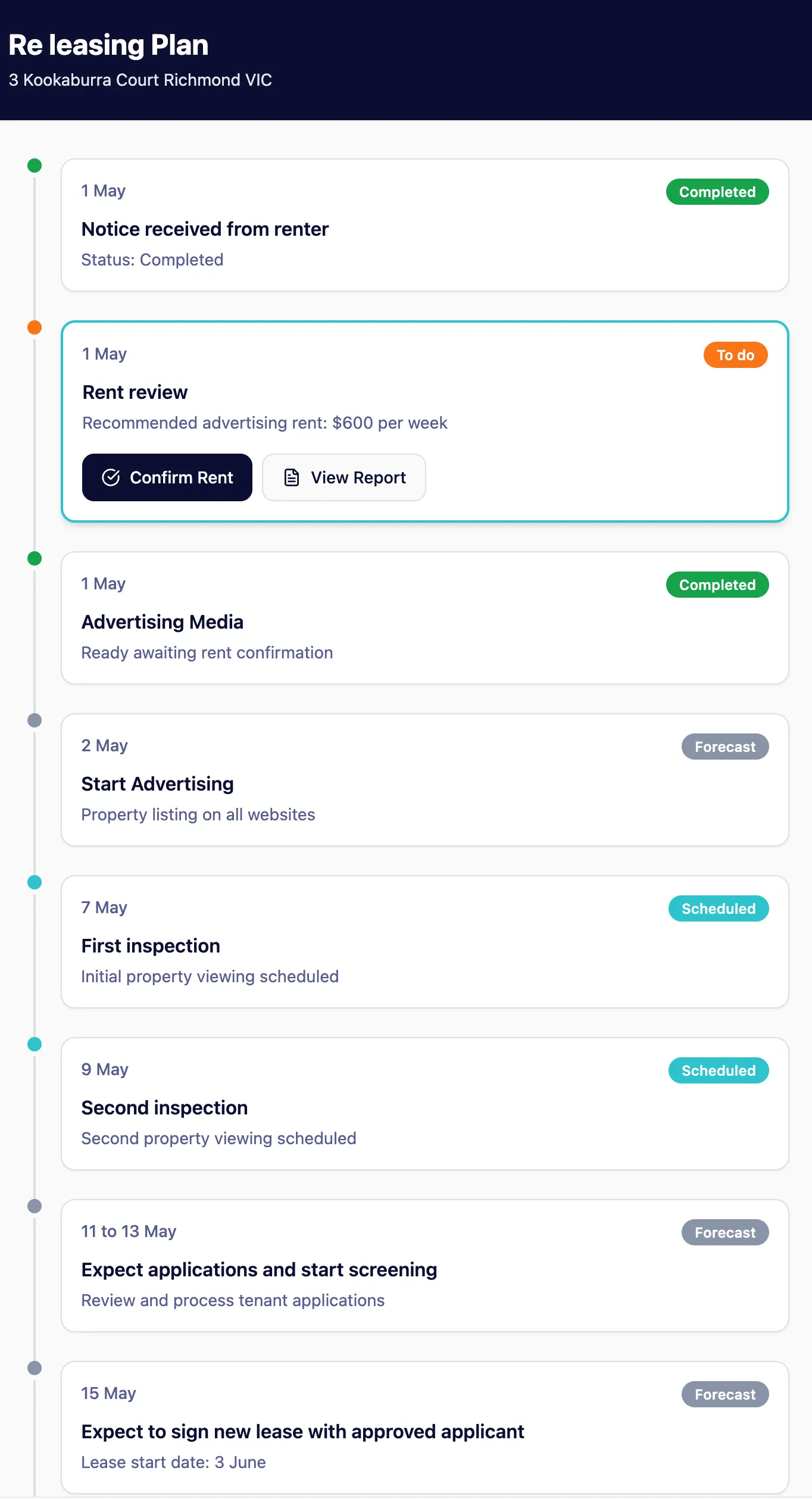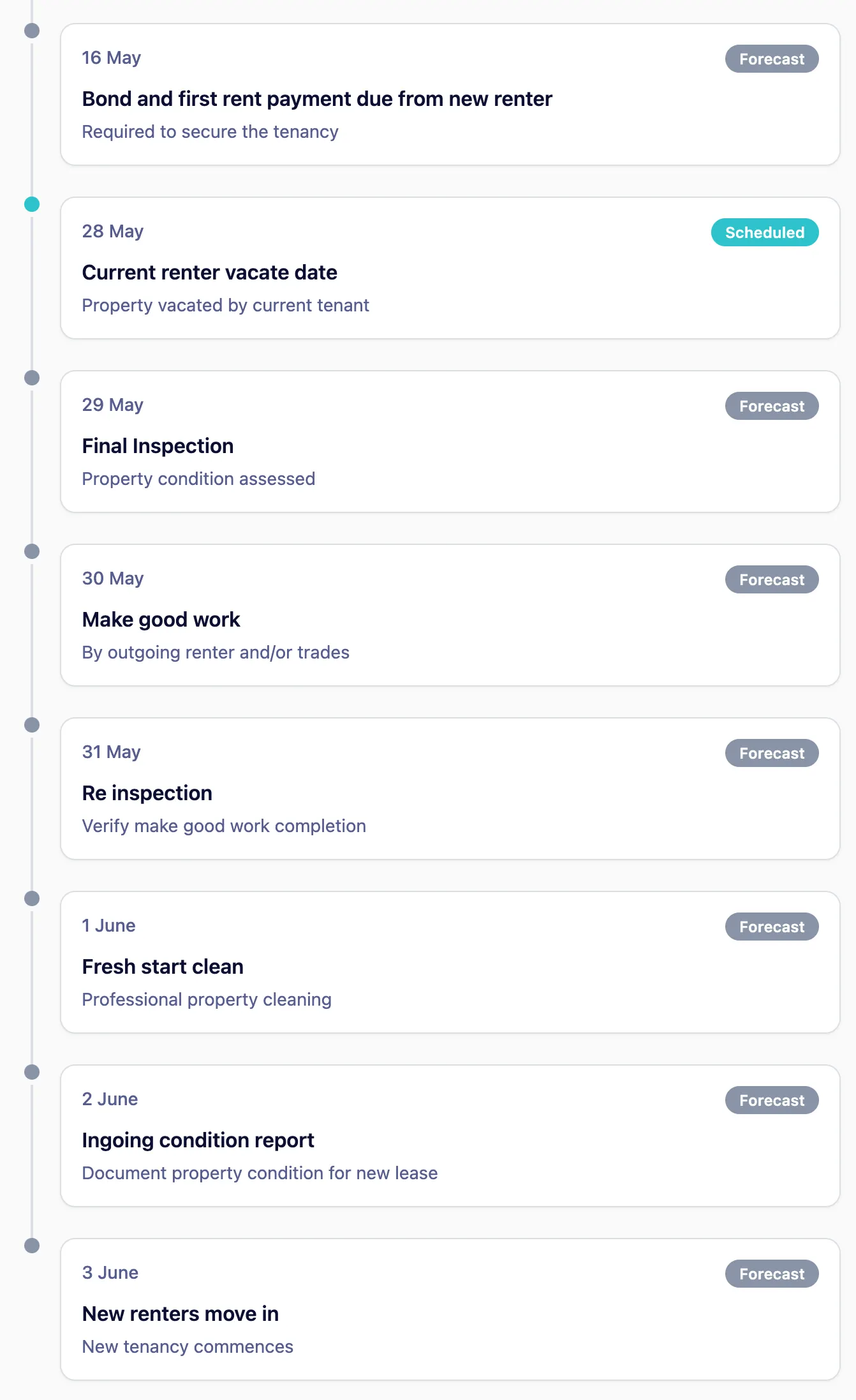
By
Michael Gilbert
•
21
November 2025
When your tenant gives notice that they are leaving, the clock starts ticking on vacancy. A good property manager should treat this as a project with a clear plan of steps, dates, and targets, not a vague wait and see period.
This guide is written for residential property investors who already use a property manager and want to know whether that manager is doing a good job when a tenant decides to move out and you need a new one. The guidance is based on Victorian legislation and best re leasing practice.
If your tenant gives notice in Victoria, your property manager should at minimum:
If your manager cannot explain these steps simply, that is a red flag.
What your property manager should provide
When a renter gives notice in Victoria, your property manager should give you a clear Re leasing Plan on the same day (or following day at the latest). It does not need to be complex. It should simply show the key dates, actions, and approvals needed to keep vacancy low. It also helps you see when things are running behind and vacancy is at risk. A strong manager will have their own version of this, even if they do not call it a Re leasing Plan.
What should happen:
Your only decisions at this stage are to confirm the advertising rent and provide guidance on preferred lease length so the manager knows whats available to new prospective renters.
What should happen:
At this stage you should know when the ad goes live, when people will walk through, and when you can expect an update on interest.
What should happen:
Your role here is to choose the renter, not chase paperwork. Ideally this is finalised 1-2 weeks before the existing renter vacates to keep vacancy low.
What should happen:
A rushed manager cuts corners here, leaving the new renters with a property that is not ready and missing issues that should have been claimed from the outgoing renter. A good manager allows enough time between renters, ideally 5 days, so the new renter arrives to a clean and prepared property and you're not out of pocket from ignored issues the previous tenant should have fixed.
What should happen:
By this point you should feel that the whole changeover followed a clear plan that you could follow along with, rather than feeling in the dark.
In Cubbi this Re leasing Plan appears automatically in your timeline so you can see exactly what is happening and what comes next. You only need to approve the advertising rent and the selected renter. Everything else is handled for you.
Learn more about Cubbi.


Most legal detail can sit in the background, but there are a few rules that directly affect vacancy and access. These are the ones that actually matter to passive investors.
In Victoria, inspections for prospective renters can take place in the final 21 days of the tenancy unless the current renter agrees otherwise.
Within this period:
A good manager will manage the relationship with the renter so the process feels respectful and cooperative rather than leaning on formal notices.
In Victoria renters must give at least 28 days written notice if they want to leave at the end of a rental agreement or if the agreement has rolled into a month-to-month lease.
You cannot demand more notice than the law allows, even if a special condition says otherwise. A good manager builds this into the Re leasing Plan rather than acting surprised when notice comes in.
There is no rule that stops a manager from signing a new lease before the current renter has moved out, as long as the new lease starts after the vacate date (ofcourse!)
However, if the outgoing renter delays handing back the keys or stays past the vacate date, the new renter may not be able to move in on time. This can lead to:
For this reason, a good manager only signs a new lease early when they are confident the outgoing renter will vacate on time and the property will be ready.
These patterns quietly cost owners money and create the feeling that the manager is not really in control.
Waiting for the property to be empty or needing new photos adds vacancy days. Advertising should begin the day after notice is received when the renter has given proper notice. If your manager only starts thinking about advertising after keys are returned, that is a major red flag.
This is a sensitive time for the renter. Bond cleaning, inspections, and packing all happen at once. A good manager knows when to stop sending automated messages and start having real conversations.
Done well, this:
Ignored, it creates blocked access, rushed cleans, and more bond disputes.
A same day changeover is tempting but often unrealistic. Around 5 days between renters usually provides enough time to complete the final inspection, allow make good, organise trades, and properly prepare the property.
Without this buffer, managers either cut corners or pass problems to the next renter. Both cost more in the long run.
Even if there has been a recent rent increase, in Victoria you can still advertise at a higher amount. This is different from Queensland where rent increases are tied to a property rather than a tenancy.
Many managers handle rent reviews for existing renters cautiously, but the re leasing stage is different. When you have 4 or more weeks before the property becomes vacant, it can be worth testing a slightly higher price if the market supports it. The key is to base on a realistic figure, not hope.
A proper rent review for re leasing should compare:
The goal is to set a rent that attracts a strong tenant who can move in within a week of the previous renter leaving, not repeat an old number or chase a stretch price that creates long vacancy.
These questions tell you immediately whether your manager is on top of things.
A good manager will answer these confidently and in plain language. If the answers are vague or defensive, this vacancy is your chance to reconsider who manages your property.
When a renter gives notice in Victoria, you do not need to learn the entire Act. You need a manager who can show you a simple Re leasing Plan, explain how they will keep vacancy under control, and give you confidence that the process is being handled properly.
Use this guide as a checklist. Compare each step against what your manager is doing. If you cannot see a clear plan to have a new renter move in within a week of the existing one leaving, this may be the right moment to upgrade from a person who reacts to a system that follows a clear plan every single time. Learn more about Cubbi.